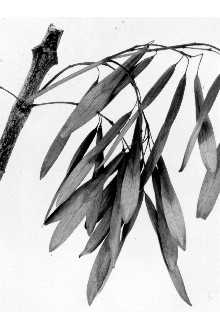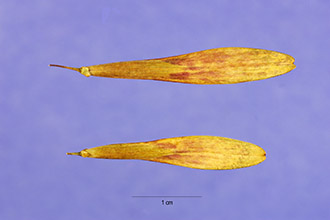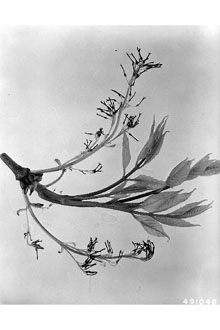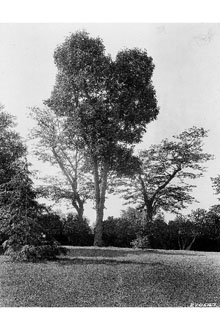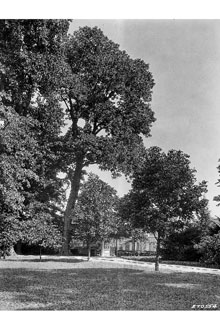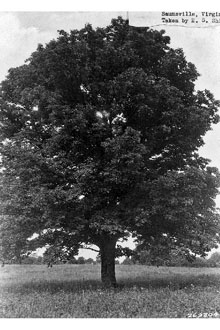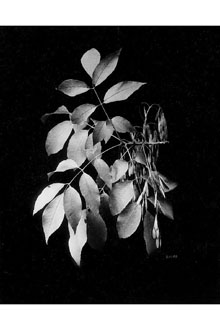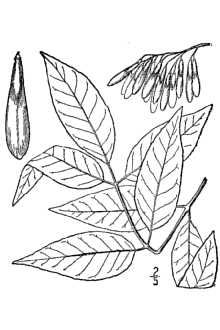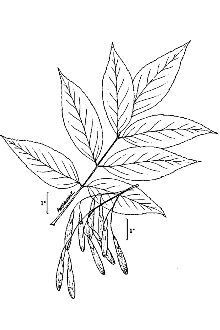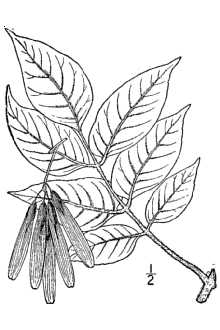Fraxinus americana L. var. curtissii (Vasey) Small
Scientific Name: Fraxinus americana L. var. curtissii (Vasey) Small
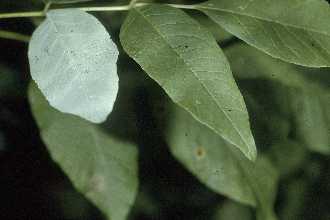
| General Information | |
|---|---|
| Usda Symbol | FRAMC2 |
| Group | Dicot |
| Life Cycle | Perennial |
| Growth Habits | Tree |
| Native Locations | FRAMC2 |
Plant Guide
Uses
White ash is a good tree for open areas such as parks and campuses; it also is used as a lawn, shade, and street tree, even though its potential large size can make it incongruous with a small area. It is an erect, graceful tree, often with bronze-purple fall foliage. It is easy to transplant and numerous cultivars have been developed, including seedless (male) forms. Other selections are based on yellow to orange and purple fall colors, persistence of leaves in the fall, height, crown shape (broadly to narrowly oval) and density, growth vigor, and cold hardiness. White ash also has been used in re-vegetating disturbed sites. The wood of white ash is valued for its strength, hardness, heavy weight, and elasticity (shock resistance). Native Americans appreciated its usefulness for tools and implements, and it is used extensively today for tool handles. Its use in wooden baseball bats is famous. The wood is also used in furniture, doors, veneer, antique vehicle parts, railroad cars and ties, canoe paddles, snowshoes, boats, posts, ties, and fuel. White ash is the most valuable timber tree of the various ashes. White ash was used by Native Americans for a variety of medicinal purposes: a decoction of the leaves as a laxative and general tonic for women after childbirth; the seeds as an aphrodisiac, a diuretic, an appetite stimulant, a styptic, an emetic, and as a cure for fevers; and a bark tea for an itching scalp, lice, snakebite, and other sores. Juice from the leaves has been applied to mosquito bites for relief of swelling and itching. White-tailed deer and cattle browse white ash and beaver, porcupine, and rabbits may eat the bark of young trees. The seeds are eaten by wood duck, northern bobwhite, turkey, grouse, finches, grosbeaks, cardinals, fox squirrel, mice, and many other birds and small mammals. The tendency of white ash to form trunk cavities makes it valuable for cavity nesters such as redheaded, red-bellied, and pileated woodpeckers. Once primary nest excavators have opened up the bole, it is an excellent habitat for secondary nesters such as wood ducks, owls, nuthatches, and gray squirrels.
Status
Please consult the PLANTS Web site and your State Department of Natural Resources for this plant’s current status, such as, state noxious status and wetland indicator values.
Description
General: Olive family (Oleaceae). Native trees growing to 20-30 m tall, maintaining a central leader (strong apical dominance) in youth with an even distribution of branches, developing a dense, conical or rounded crown at maturity. The trunk is long, straight, and free of branches for most of its length (except when open grown). The bark is thick, dark gray, with a uniform, diamond-shaped ridge and Plant Materials <http://plant-materials.nrcs.usda.gov/> Plant Fact Sheet/Guide Coordination Page <http://plant-materials.nrcs.usda.gov/intranet/pfs.html> National Plant Data Center <http://npdc.usda.gov>
Distribution
White ash grows over most of eastern North America, absent only from the outer Atlantic and Gulf coastal plains, It occurs from Nova Scotia west to eastern Minnesota and south to Texas and northern Florida, northward barely into southern Quebec and Ontario, It is cultivated in Hawaii, Use soil moisture sensors to measure the soil moisture of Fraxinus americana L. var. curtissii (Vasey) Small., For current distribution, please consult the Plant Profile page for this species on the PLANTS Web site,
Establishment
Adaptation: White ash grows best on deep, well-drained, moist soils with other hardwoods at elevations of about 0-1050 meters. It rarely forms pure stands. It occurs on middle slopes in the Northeast, on slightly elevated ridges in the floodplains of major streams in the coastal plain, and on slopes along major streams in the central states. Primary associates are eastern white pine, northern red oak, white oak, sugar maple, red maple, yellow birch, American beech, black cherry, eastern hemlock, and yellow poplar. White ash is primarily characteristic of early and intermediate stages of succession. The seedlings are shade tolerant but can also establish in full sun. Mature individuals are shade intolerant – after persisting for a few years in moderately dense shade, trees developing inside closed stands reach the overstory by responding quickly to openings in the canopy. General: White ash begins producing seed at a minimum age of 20 years. A good seed crop is produced at intervals of 2-3 years, although the males flower heavily each year. To best overcome dormancy, stratify under moist conditions for 30 days at 14/30° C (night/day) then for 60 days at 5° C. A forest floor seed bank may retain viable white ash seeds for 3-4 years. Germination can occur on mineral soil, humus, or leaf litter, and seedlings develop best in partial sun. Mature trees may reach 200 years of age. White ash resprouts from the root crown after logging or fire. Sprouting ability decreases with age.
Management
White ash prefers moist, deep soils for best growth but is adaptable to a wide range of soil pH. Full sun is best. Young plants are easily transplanted and established. White ash has been successfully used in the reclamation of strip mines in Ohio, Kentucky, and Pennsylvania. Seedlings provide a better start than direct seeding, and planting should be in mixtures with other hardwoods. White ash is more ornamental than green ash (Fraxinus pennsylvanica) but is less adaptable, grows at a slower rate, and is more susceptible to pests and diseases. Bud grafting generally propagates white ash cultivars. The species also can be propagated by conventional methods of grafting and layering; open field and bench grafting of unpotted stock have been successful. Fire kills the aboveground stem and crown of white ash, but it resprouts from the root crown after fire. White ash is moderately susceptible to decay and insect damage induced through fire damage.
Environmental Concerns
Concerns
Concerns
Ash decline (or “ash dieback” or “ash yellows”) is the most serious problem affecting white ash. The decline is especially prevalent in New York, Pennsylvania and Vermont but occurs from the Great Plains to the Atlantic coast at 39°–45° N latitude. Mycoplasma-like organisms (MLO, the cause of ash yellows) have been found associated with most of the dying trees.Not all dying trees are infected and ash decline is thought to result from multiple causes – MLO plus various fungi and viruses, as well as atmospheric pollution and drought. Maintenance of good tree vigor is the primary control recommendation. White ash is sensitive to ozone, sulfur dioxide, nitrous oxides, and associated acid deposition, which may cause the appearance of necrotic lesions on the leaves. Most of recent ash decline has occurred in areas with high levels of these gases. Cultivars, Improved and Selected Materials (and area of origin) Contact your local Natural Resources
Conservation
Service (formerly Soil Conservation Service) office for more information. Look in the phone book under ”United States Government.” The Natural Resources Conservation Service will be listed under the subheading “Department of Agriculture.” These plant materials are readily available from commercial sources.
References
Griffith, R.S. 1991. Fraxinus americana. IN: W.C. Fischer (compiler). The fire effects information system [Data base]. USDA Forest Service, Intermountain Research Station, Intermountain Fire Sciences Laboratory, Missoula, Montana. <http://fire.org/feis/plants/tree/fraame/all_frames.htm l> Schlesinger, R.C. 1990. Fraxinus americana L. White Ash. Pp. 333-338, in R.M. Burns and B.H. Honkala (tech. coords.). Silvics of North America. Volume 2. Hardwoods. USDA Forest Service Agric. Handbook 654, Washington, D.C. <http://willow.ncfes.umn.edu/silvics_manual/volume _2/fraxinus/americana.htm> USDA, NRCS 1993. Northeast wetland flora: Field office guide to plant species. Wetland Science Institute, Laurel, Maryland.
Plant Traits
Growth Requirements
| Temperature, Minimum (°F) | -34 |
|---|---|
| Adapted to Coarse Textured Soils | Yes |
| Adapted to Fine Textured Soils | No |
| Adapted to Medium Textured Soils | Yes |
| Anaerobic Tolerance | Low |
| CaCO3 Tolerance | Medium |
| Cold Stratification Required | Yes |
| Drought Tolerance | Low |
| Fertility Requirement | High |
| Fire Tolerance | Medium |
| Frost Free Days, Minimum | 90 |
| Hedge Tolerance | None |
| Moisture Use | High |
| pH, Maximum | 7.5 |
| pH, Minimum | 4.7 |
| Planting Density per Acre, Maxim | 800 |
| Planting Density per Acre, Minim | 300 |
| Precipitation, Maximum | 80 |
| Precipitation, Minimum | 28 |
| Root Depth, Minimum (inches) | 40 |
| Salinity Tolerance | Medium |
| Shade Tolerance | Intolerant |
Morphology/Physiology
| Bloat | None |
|---|---|
| Toxicity | None |
| Resprout Ability | Yes |
| Shape and Orientation | Erect |
| Active Growth Period | Spring and Summer |
| C:N Ratio | High |
| Coppice Potential | Yes |
| Fall Conspicuous | Yes |
| Fire Resistant | No |
| Flower Color | Yellow |
| Flower Conspicuous | No |
| Foliage Color | Green |
| Foliage Porosity Summer | Dense |
| Foliage Porosity Winter | Porous |
| Foliage Texture | Fine |
| Fruit/Seed Conspicuous | Yes |
| Nitrogen Fixation | None |
| Low Growing Grass | No |
| Lifespan | Moderate |
| Leaf Retention | No |
| Known Allelopath | No |
| Height, Mature (feet) | 90.0 |
| Height at 20 Years, Maximum (fee | 40 |
| Growth Rate | Moderate |
| Growth Form | Single Stem |
| Fruit/Seed Color | Brown |
Reproduction
| Vegetative Spread Rate | None |
|---|---|
| Small Grain | No |
| Seedling Vigor | Medium |
| Seed Spread Rate | Moderate |
| Fruit/Seed Period End | Fall |
| Seed per Pound | 10000 |
| Propagated by Tubers | No |
| Propagated by Sprigs | No |
| Propagated by Sod | No |
| Propagated by Seed | Yes |
| Propagated by Corm | No |
| Propagated by Container | Yes |
| Propagated by Bulb | No |
| Propagated by Bare Root | Yes |
| Fruit/Seed Persistence | No |
| Fruit/Seed Period Begin | Summer |
| Fruit/Seed Abundance | High |
| Commercial Availability | Routinely Available |
| Bloom Period | Mid Spring |
| Propagated by Cuttings | No |
Suitability/Use
| Veneer Product | No |
|---|---|
| Pulpwood Product | No |
| Post Product | No |
| Palatable Human | No |
| Palatable Browse Animal | Medium |
| Nursery Stock Product | Yes |
| Naval Store Product | Yes |
| Lumber Product | Yes |
| Fuelwood Product | High |
| Fodder Product | No |
| Christmas Tree Product | No |
| Berry/Nut/Seed Product | No |

